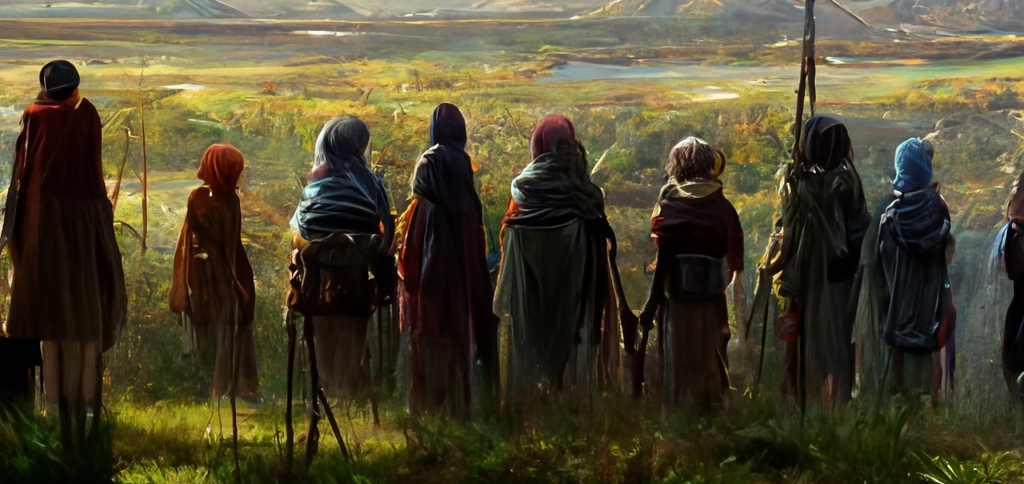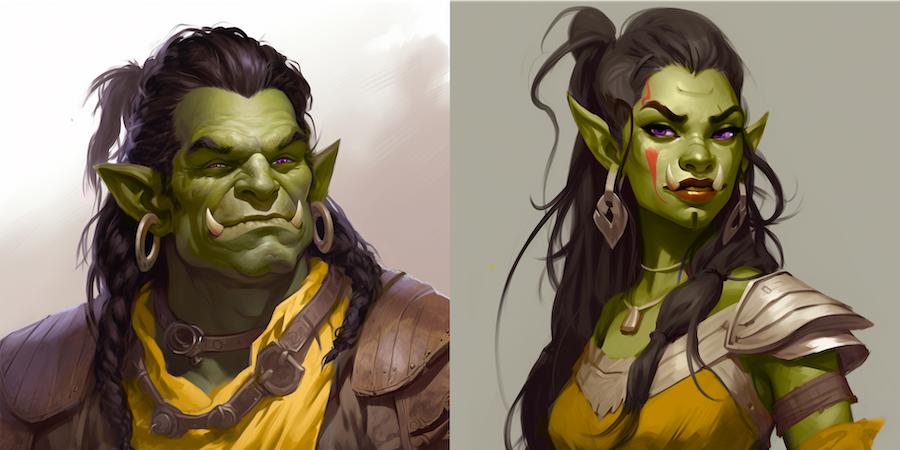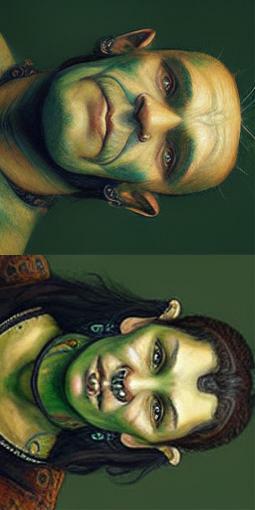Orc
Orcs are a sentient species originally thought to be native to the Galisean continent, but with large and distinctive communities that have evolved in both Felora and Galisea. Orcish societies found on the two continents are quite different and are even noticably different phenotypically. In Galisea, the orcish people have established a large and powerful, if somewhat loosely organized state in the form of the Terruk-Mal, with Feloran Orcs developing into smaller decentralized tribal societies.
Orcs have a reputation as cruel and bloodthirsty raiders and as such are viewed as little more than vicious barbarians in neighboring settled societies. This reputation is however, a gross caricature of orcish societies, which, while valuing courage and battle prowess are possess a keen interest in various religious orders, and are not especially bloodthirsty.
Basic Information
Anatomy
Orcs possess the same basic body type as most other sentient species in Getninia possessing an upright body posture, two legs, two arms, and one head. Orcs have hands with tactile fingers and opposable thumbs, lacking opposable toes. They have two ears, a nose, and two eyes on their face. Orcs tend to have thick body and head hair, though Galisean orcs lack any sort of facial hair, with Feloran orcs being variable as to whether or not they can grow facial hair.
Biological Traits
Orcs tend to live short lives, often dying relatively young due to violence, untreated illness, and other causes of early death, and further their basic biology breaking down faster than that of other species. Galisean Orcs rarely see their sixth decade. Feloran orcs live a somewhat longer time, with those that take good care of themseles living about a hundred years or so in good conditions. Rare examples of orcs living longer can mostly be chalked up to intensive use of magic.
Orcs tend to be quite tall, approaching or even exceeding two meters in height and being quite stocky to boot, with weights over one hundred kilograms being the norm. They also possess thick skin, hardy organs, and an abundance of fast and slow twitch muscles that make orcs much stronger and tougher than most other sentient beings. Their metabolisms are also lightning fast making them more effective athletes at the cost of a shorter lifespan.
Orcs vary greatly in coloration and facial features depend on whether they are northern or southern orcs. Feloran orcs have green skin, though the tone varies, with white, grey, black, or brown hair, often with a bluish undertone and usually brown, though variable eye colors. They also tend to have pronounced tusks that jut out at least two centimeters from their lower lips. Galisean orcs usually have light grey or pale skin, flat black hair, and grey, brown, or black eyes. Their tusks are also less pronounced, protruding less than a centimeter on average.
Additional Information
Social Structure
Orcs prefer to live relatively close knit clans that are part of larger tribes. Within these tightly confined structures most everything is shared, and cooperation and common work are absolutely the norm, and seen as desirable. Outside these communites competition is the norm, though open conflict is somewhat uncommon within tribes, favoring ritualistic combat, or raiding being the primary means of violently airing grievances.
Geographic Origin and Distribution
Orcs are found in both Galisea and Felora in large numbers. In Galisea, the largest single concentration of orcs is in the Terruk-Mal where a mostly Orcish ruling class reigns over most of the central region of the continent, with other orcs scattered throughout the continent in smaller isolated communities. In Felora, most orcs live in the northern part of the continent in many of the "uncivilized" lands surrounding what is considered "Inner Felora".
Average Intelligence
Orcs have a reputation for being superstitious and dull, though this is, in large part a gross exaggeration of their cognitive abilities. Orcs can perform well in academia, and other fields requiring intelligence, and there is no biological inhibition for it, though cultural factors do sometimes push such scholarly tendencies out of the mainstream.
Perception and Sensory Capabilities
Orcs have five basic senses, sight, hearing, smell, taste, and touch. Orcs tend towards vision as their primary sense, though they possess good hearing as well. They also have a sense of smell stronger than most other sentient beings, and some exceptional individuals develop their skill with smell in order to use it to track targets over long distances. Orcs can see well at night, capable of seeing even in complete darkness, though they cannot see color without a reasonable amount of light.
Civilization and Culture
Major Organizations
Orcs generally live loosely affiliated, tribal societies with extended clans forming the basis of most orcish social strata. However, in coastal Felora, and in Central Galisea, large states have formed. In Felora, the coastal communities have confederated into the Northwestern Tribes, a crude, but very powerful pirate confederacy that dominates much of the southern Tealestrian Sea. In Galisea, Terruk-Mal, is the central power in the continental heartland.
Orcish societies lack major religions, often being practicioners of tribally relevant druidic faiths that are, at best, loosely affiliated along continental lines. Other societies that are magical in nature are quite rare as well, though the various Galisean orcs have created a society of warchanters, who provide support for warbands and often serve as a diplomatic caste. Continent spanning druidic orders may exist, but their existence cannot be confirmed.
Orcish mercenary bands are quite common, often in areas bordering orcish territories. Their reputation as brutal killers helps secure contracts, particularly in service as elite shock troops by wealthy benefactors who are unconcerned with the potential for collateral damage. Martial organizations also exist, particularly in Galisea, where the Terruk-Mal has fostered them in order to increase training and discipline among their levied troops.
Average Technological Level
Orcs are by in large comparatively underdeveloped technologically, on account of being deprived resources and often on account of being abducted for use as slaves, or otherwise relegated to a status as outsiders to most "civilized" lands. They, as a result have had made do with these limited resources, nonetheless producing unique technologies. Chief among these is the war bow, a uniquely Terruk invention that enables them to utilize their full might when drawing a bow, and dealing maximal damage as a result.
Major Language Groups and Dialects
Galisean Orcs speak a number of languages, often originating from the northern parts of the continent, though the dominant is Terruk, which is the official spoken language of the Terruk-Mal. Galisean orcs typically write in the Fuí language, which has been the official Terruk written language since the Terruk clans adopted a more centralized state. Feloran orcs speak a number of languages, though most have retained Feloran, the language of their ancient slavers, for convienence if nothing else.
Genetic Descendants
Lifespan
Galisean: ~40-55 years, Feloran: ~60-75 years (rarely up to 100)
Average Height
1.79-2,13 m
Average Weight
104-117 kg
Related Organizations
Related Ethnicities
DnD (5e) Traits
- Medium Size
- Base walking speed of 30 feet
- Proficiency in Common, Terruk or D'jo, and any one other language of your choice.
- 60 ft. Darkvision
- Can move up to walking speed towards closest enemy you can detect, must move closer to them.
- Considered one size larger for the purposes of carrying capacity and the weight you can push, drag, or lift.
- Proficiency with two of the Animal Handling, Insight, Intimidation, Medicine, Nature, Perception, and Survival skills.
- +2 to Strength, +1 to any one other stat




